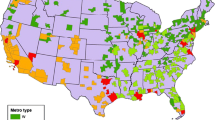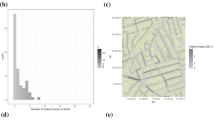Abstract
Neighborhood boundaries are a defining aspect of highly segregated urban areas. Yet, few studies examine the particular challenges and spatial processes that occur at the bordering region between two neighborhoods. Extending the growing literature on spatial interdependence, this article argues that neighborhood boundaries—defined as sharp changes in the racial or socioeconomic composition of neighborhoods—are a salient feature of the spatial structure with implications for violent crime and other outcomes. Boundaries lack the social control and cohesion of adjacent homogeneous areas, are contested between groups provoking intergroup conflict, and create opportunities for criminal behavior. This article presents evidence linking racial neighborhood boundaries to increased violent crime. The findings illustrate the importance of neighborhood boundaries for our understanding of spatial dimensions of population dynamics above and beyond the characteristics of neighborhoods.

Similar content being viewed by others
Notes
Also note Pattillo’s later work (2013), in which she argued that members of the black middle class often reside at the boundary between white middle-class communities and poor black neighborhoods. This location influences the opportunities and disadvantages of the black middle class in important ways (see also Sharkey 2014).
The correlation between boundary values based on Wombling and edge intensity as an alternative boundary detection method used by Legewie and Schaeffer (2016) ranges from 0.71 for proportion Hispanic to 0.74 for proportion African American.
The definition of the index is \( HH1=1-{\sum}_{i=1}^I{s}_i^2 \), where s is the population share of group i, and I is the number of groups in a given census block.
Major roads are based on the 2010 TIGER/Line Files (U.S. Census Bureau 2012) and are defined as either divided, limited-access highways or main arteries that are part of the U.S. highway, state highway, or county highway system (primary or secondary roads).
References
Anderson, E. (1990). Streetwise: Race, class, and change in an urban community. Chicago, IL: University of Chicago Press.
Andrews, K. T., & Seguin, C. (2015). Group threat and policy change: The spatial dynamics of prohibition politics, 1890-1919. American Journal of Sociology, 121, 475–510.
Angrist, J. D., & Pischke, J.-S. (2008). Mostly harmless econometrics: An empiricist’s companion. Princeton, NJ: Princeton University Press.
Anselin, L. (2003). Spatial externalities, spatial multipliers, and spatial econometrics. International Regional Science Review, 26, 153–166.
Bergesen, A., & Herman, M. (1998). Immigration, race, and riot: The 1992 Los Angeles uprising. American Sociological Review, 63, 39–54.
Blackwell, M., Honaker, J., & King, G. (2017). A unified approach to measurement error and missing data: Overview and applications. Sociological Methods & Research, 46, 303–341.
Blalock, H. M. (1967). Toward a theory of minority-group relations. New York, NY: Capricorn Books.
Blumer, H. (1958). Race prejudice as a sense of group position. Pacific Sociological Review, 1, 3–7.
Brantingham, P. L., Brantingham, P. J., Vajihollahi, M., & Wuschke, K. (2009). Crime analysis at multiple scales of aggregation: A topological approach. In D. Weisburd, W. Bernasco, & G. J. Bruinsma (Eds.), Putting crime in its place (pp. 87–107). New York, NY: Springer.
Campbell, E., Henly, J. R., Elliott, D. S., & Irwin, K. (2009). Subjective constructions of neighborhood boundaries: Lessons from a qualitative study of four neighborhoods. Journal of Urban Affairs, 31, 461–490.
Charles, C. Z. (2003). The dynamics of racial residential segregation. Annual Review of Sociology, 29, 167–207.
Dale, M. R. T., & Fortin, M.-J. (2014). Spatial analysis: A guide for ecologists (2nd ed.). Cambridge, UK: Cambridge University Press.
DeSena, J. N. (1990). Protecting one’s turf: Social strategies for maintaining urban neighborhoods. Lanham, MD: University Press of America.
Desmond, M., & Valdez, N. (2012). Unpolicing the urban: Poor consequences of third-party policing for inner-city women. American Sociological Review, 78, 117–141.
Dormann, C. F., McPherson, J. M., Araujo, M. B., Bivand, R., Bolliger, J., Carl, G., . . . Wilson, R. (2007). Methods to account for spatial autocorrelation in the analysis of species distributional data: A review. Ecography, 30, 609–628.
Downey, L. (2006). Using geographic information systems to reconceptualize spatial relationships and ecological context. American Journal of Sociology, 112, 567–612.
Drake, S. C., & Cayton, H. R. (1993). Black metropolis: A study of Negro life in a northern city. Chicago, IL: University of Chicago Press. (Original work published 1945)
Ellis, M., Wright, R., & Parks, V. (2004). Work together, live apart? Geographies of racial and ethnic segregation at home and at work. Annals of the Association of American Geographers, 94, 620–637.
Fagan, W. F., Fortin, M.-J., & Soykan, C. (2003). Integrating edge detection and dynamic modeling in quantitative analyses of ecological boundaries. BioScience, 53, 730–738.
Gelman, A., & Hill, J. (2007). Data analysis using regression and multilevel/hierarchical models. Cambridge, UK: Cambridge University Press.
Grimshaw, A. D. (1960). Urban racial violence in the United States changing ecological considerations. American Journal of Sociology, 66, 109–119.
Hipp, J. R., Faris, R. W., & Boessen, A. (2012). Measuring “neighborhood”: Constructing network neighborhoods. Social Networks, 34, 128–140.
Hipp, J. R., Tita, G. E., & Boggess, L. N. (2011). A new twist on an old approach: A random-interaction approach for estimating rates of inter-group interaction. Journal of Quantitative Criminology, 27, 27–51.
Hirschman, A. O. (1964). The paternity of an index. American Economic Review, 54, 761–762.
House, J. S., Kaplan, G. A., Morenoff, J., Raudenbush, S. W., Williams, D. R., & Young, E. A. (2012). Chicago Community Adult Health Study, 2001–2003 (Technical Report No. ICPSR31142-v1). Ann Arbor, MI: Inter-university Consortium for Political and Social Research. https://doi.org/10.3886/ICPSR31142.v1
Hwang, J. (2016). The social construction of a gentrifying neighborhood: Reifying and redefining identity and boundaries in inequality. Urban Affairs Review, 52, 98–128.
Jacquez, G. M., Maruca, S., & Fortin, M.-J. (2000). From fields to objects: A review of geographic boundary analysis. Journal of Geographical Systems, 2, 221–241.
Janowitz, M. (1979). Patterns of collective racial violence. In H. D. Graham & T. R. Gurr (Eds.), Violence in America: Historical and comparative perspectives (pp. 393–422). Beverly Hills, CA: Sage Publications.
Johnston, R., Poulsen, M., & Forrest, J. (2007). The geography of ethnic residential segregation: A comparative study of five countries. Annals of the Association of American Geographers, 97, 713–738.
Kim, Y.-A., & Hipp, J. R. (2017). Physical boundaries and city boundaries: Consequences for crime patterns on street segments? Crime & Delinquency, 64, 227–254.
Kramer, R. (2017). Defensible spaces in Philadelphia: Exploring neighborhood boundaries through spatial analysis. Russell Sage Foundation Journal of the Social Sciences, 3(2), 81–101.
Lamont, M., & Molnar, V. (2002). The study of boundaries in the social sciences. Annual Review of Sociology, 28, 167–195.
Law, T., & Legewie, J. (Forthcoming). Urban data science. In R. A. Scott, M. Buchmann, & S. M. Kosslyn (Eds.), Emerging trends in the social and behavioral sciences. New York, NY: John Wiley & Sons.
Legewie, J. (2012). Die schätzung von kausalen effekten: Überlegungen zu methoden der kausalanalyse anhand von kontexteffekten in der schule [The estimation of causal effects: An introduction into methods of causal analysis based on peer effects in education]. Kölner Zeitschrift für Soziologie und Sozialpsychologie, 64, 123–153.
Legewie, J. (2018). Neighborhood boundaries and violent crime. An introduction to boundary detection methods in R (SocArXiv Papers). https://doi.org/10.31235/osf.io/jc78a
Legewie, J., & Schaeffer, M. (2016). Contested boundaries: Explaining where ethno-racial diversity provokes neighborhood conflict. American Journal of Sociology, 122, 125–161.
Liang, S., Banerjee, S., & Carlin, B. P. (2009). Bayesian wombling for spatial point processes. Biometrics, 65, 1243–1253.
Logan, J. R. (2012). Making a place for space: Spatial thinking in social science. Annual Review of Sociology, 38, 507–524.
Logan, J. R., Spielman, S., Xu, H., & Klein, P. N. (2011). Identifying and bounding ethnic neighborhoods. Urban Geography, 32, 334–359.
Long, J. S., & Freese, J. (2005). Regression models for categorical dependent variables using Stata (2nd ed.). College Station, TX: Stata Press.
Lu, H., & Carlin, B. P. (2005). Bayesian areal wombling for geographical boundary analysis. Geographical Analysis, 37, 265–285.
Lu, H., Reilly, C. S., Banerjee, S., & Carlin, B. P. (2007). Bayesian areal wombling via adjacency modeling. Environmental and Ecological Statistics, 14, 433–452.
Lynch, J. P., & Addington, L. A. (2006). Understanding crime statistics: Revisiting the divergence of the NCVS and the UCR. London, UK: Cambridge University Press.
Lynch, K. (1960). The image of the city (1st ed.). Cambridge, MA: MIT Press.
Morenoff, J. D., & Sampson, R. J. (1997). Violent crime and the spatial dynamics of neighborhood transition: Chicago, 1970–1990. Social Forces, 76, 31–64.
Morenoff, J. D., Sampson, R. J., & Raudenbush, S. W. (2001). Neighborhood inequality, collective efficacy, and the spatial dynamics of urban violence. Criminology, 39, 517–558.
Morgan, S. L., & Winship, C. (2014). Counterfactuals and causal inference: Methods and principles for social research. Cambridge, UK: Cambridge University Press.
Olzak, S. (1994). The dynamics of ethnic competition and conflict. Stanford, CA: Stanford University Press.
Osgood, D. W. (2000). Poisson-based regression analysis of aggregate crime rates. Journal of Quantitative Criminology, 16, 21–43.
Pattillo, M. (2005). Black middle-class neighborhoods. Annual Review of Sociology, 31, 305–329.
Pattillo, M. (2007). Black on the block: The politics of race and class in the city. Chicago, IL: University of Chicago Press.
Pattillo, M. E. (2013). Black picket fences: Privilege and peril among the black middle class. Chicago, IL: University of Chicago Press.
Rieder, J. (1985). Canarsie: The Jews and Italians of Brooklyn against liberalism. Cambridge, MA: Harvard University Press.
Roberto, E. (2015). Spatial boundaries and the local context of residential segregation (arXiv:1509.02574 [physics.soc-ph]). Retrieved from https://pdfs.semanticscholar.org/0cb0/4b5d06078f50c0d6c561e67b4543f26c91ea.pdf
Rubin, D. B. (2004). Multiple imputation for nonresponse in surveys. New York, NY: John Wiley & Sons.
Sampson, R. J. (2012). Great American city: Chicago and the enduring neighborhood effect. Chicago, IL: University of Chicago Press.
Sampson, R. J., & Groves, W. B. (1989). Community structure and crime: Testing social-disorganization theory. American Journal of Sociology, 94, 774–802.
Sampson, R. J., Morenoff, J. D., & Earls, F. (1999). Beyond social capital: Spatial dynamics of collective efficacy for children. American Sociological Review, 64, 633–660.
Sampson, R. J., Raudenbush, S. W., & Earls, F. (1997). Neighborhoods and violent crime: A multilevel study of collective efficacy. Science, 277, 918–924.
Shadish, W. R., Clark, M. H., & Steiner, P. M. (2008). Can nonrandomized experiments yield accurate answers? A randomized experiment comparing random and nonrandom assignments. Journal of the American Statistical Association, 103, 1334–1344.
Shapiro, L. G., & Stockman, G. C. (2001). Computer vision. Upper Saddle River, NJ: Prentice Hall.
Sharkey, P. (2014). Spatial segmentation and the black middle class. American Journal of Sociology, 119, 903–954.
Song, J., Andresen, M. A., Brantingham, P. L., & Spicer, V. (2017). Crime on the edges: Patterns of crime and land use change. Cartography and Geographic Information Science, 44, 51–61.
Spielman, S. E., Folch, D., & Nagle, N. (2014). Patterns and causes of uncertainty in the American Community Survey. Applied Geography, 46, 147–157.
Spielman, S. E., & Logan, J. R. (2013). Using high-resolution population data to identify neighborhoods and establish their boundaries. Annals of the Association of American Geographers, 103, 67–84.
Suttles, G. D. (1972). Social construction of communities. Chicago, IL: University of Chicago Press.
U.S. Census Bureau. (2012). 2010 TIGER/Line Shapefiles technical documentation (Technical report). Washington, DC: U.S. Department of Commerce.
Womble, W. H. (1951). Differential systematics. Science, 114, 315–322.
Acknowledgments
I thank Dave Brady, Rory Kramer, Merlin Schaeffer, and Patrick Sharkey for helpful comments and discussions. An example analysis with software to implement different boundary detection methods is available at https://osf.io/preprints/socarxiv/jc78a (Legewie 2018). Replication materials for all results in this article are available online at https://osf.io/hfjgw/.
Author information
Authors and Affiliations
Corresponding author
Electronic supplementary material
ESM 1
(PDF 168 kb)
Rights and permissions
About this article
Cite this article
Legewie, J. Living on the Edge: Neighborhood Boundaries and the Spatial Dynamics of Violent Crime. Demography 55, 1957–1977 (2018). https://doi.org/10.1007/s13524-018-0708-1
Published:
Issue Date:
DOI: https://doi.org/10.1007/s13524-018-0708-1




